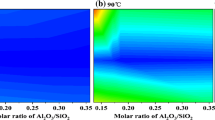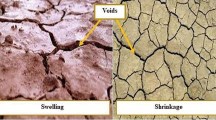Abstract
Chemical durability is one of the most important evaluation indexes of the long-term stability of solidified nuclear waste. In this study, a product consistency test method was used to explore the chemical durability of strontium-contaminated soil treated by microwave sintering. The influencing factors included soil type, soil composition, their coupling effects and the pH value of the leaching environment. The results of the research showed that strontium release is promoted in acidic or alkaline environments. The chemical stability of the sintered sample was proved to be able to meet the needs of long-term storage and the corrosion mechanism of sample was analyzed. In addition, the chemical durability of the solidified soil was related to the molar ratio of Al2O3/SiO2.







Similar content being viewed by others
References
Nathaniel SP, Alam M, Murshed M, Mahmood H, Ahmad P (2021) The roles of nuclear energy, renewable energy, and economic growth in the abatement of carbon dioxide emissions in the G7 countries. Environ Sci Pollut Res 28(35):47957–47972
Nie B, Ni M, Liu J, Zhu Z, Zhu Z, Li F (2019) Insights into potential consequences of fusion hypothetical accident, lessons learnt from the former fission accidents. Environ Pollut 245:921–931
Strand P, Sundell-Bergman S, Brown JE, Dowdall M (2017) On the divergences in assessment of environmental impacts from ionising radiation following the Fukushima accident. J Environ Radioact 169:159–173
Burger A, Lichtscheidl I (2019) Strontium in the environment: Review about reactions of plants towards stable and radioactive strontium isotopes. Sci Total Environ 653:1458–1512
Panahifar A, Chapman LD, Weber L, Samadi N, Cooper DM (2019) Biodistribution of strontium and barium in the developing and mature skeleton of rats. J Bone Miner Metab 37(3):385–398
Struthers J (1893) On the development of the bones of the foot of the horse, and of digital bones generally; and on a case of polydactyly in the horse. J Anat Physiol 28(Pt 1):51
Theill LE, Boyle WJ, Penninger JM (2002) RANK-L and RANK: T cells, bone loss, and mammalian evolution. Annu Rev Immunol 20:795
Hemkemeyer SA, Schwarzer C, Boiani M, Ehmcke J, Le Gac S, Schlatt S, Nordhoff V (2014) Effects of embryo culture media do not persist after implantation: a histological study in mice. Hum Reprod 29(2):220–233
Kasar S, Mishra S, Omori Y, Sahoo SK, Kavasi N, Arae H, Aono T et al (2020) Sorption and desorption studies of Cs and Sr in contaminated soil samples around Fukushima daiichi nuclear power plant. J Soils Sediments 20(1):392–403
Zhang S, Ding Y, Lu X, Mao X, Song M (2016) Rapid and efficient disposal of radioactive contaminated soil using microwave sintering method. Mater Lett 175:165–168
Zhang S, Shu X, Chen S, Yang H, Hou C, Mao X, Lu X et al (2017) Rapid immobilization of simulated radioactive soil waste by microwave sintering. J Hazard Mater 337:20–26
Li Z, Cao Y, Mao X, Tang H, Yan M (2021) In-situ immobilization of soil containing simulated radionuclide Ce using AC/CaCO3/Nano-HAP by microwave sintering. J Radioanal Nucl Chem 328(1):315–323
Chen S, Shu X, Tang H, Mao X, Xu C, Lu X (2019) Microwave vitrification of uranium-contaminated soil for nuclear test site and chemical stability. Ceram Int 45(10):13334–13339
Rankin WN, Kelley JA (1978) Microstructures and leachability of vitrified radioactive wastes. Nucl Technol 41(3):373–380
Vienna JD, Ryan JV, Gin S, Inagaki Y (2013) Current understanding and remaining challenges in modeling long-term degradation of borosilicate nuclear waste glasses. Int J Appl Glas Sci 4(4):283–294
Debure M, De Windt L, Frugier P, Gin S (2013) HLW glass dissolution in the presence of magnesium carbonate: diffusion cell experiment and coupled modeling of diffusion and geochemical interactions. J Nucl Mater 443(1–3):507–521
Gin S (2014) Open scientific questions about nuclear glass corrosion. Procedia Mater Sci 7:163–171
Fournier M, Ull A, Nicoleau E, Inagaki Y, Odorico M, Frugier P, Gin S (2016) Glass dissolution rate measurement and calculation revisited. J Nucl Mater 476:140–154
Seo YC, Lee SH, Lee KS, Kim IT, Kim JH (2001) Leaching behavior and characteristics of glass components and surrogate nuclides in radioactive vitrified waste forms. Environ Technol 22(12):1395–1404
Liu X, Qiao Y, Qian Z, Ma H (2018) Research on chemical durability of iron phosphate glass wasteforms vitrifying SrF2 and CeF3. J Nucl Mater 508:286–291
Chen S, Shu X, Luo F, Dong H, Xu C, Li B, Lu X et al (2019) Rapid vitrification of simulated Sr2+ radioactive contaminated soil for nuclear emergencies. J Radioanal Nucl Chem 319(1):115–121
Simmons CJ (1987) Chemical durability of fluoride glasses: III, the effect of solution pH. J Am Ceram Soc 70(9):654–661
Cui T (2014) Analysis on acidity and alkalinity of metallogenetic environment in penecontemporaneous period on the bauxite in WZD area, northern Guizhou, China. Advanced materials research, vol 989. Trans Tech Publications Ltd, Wollerau, pp 1428–1431
Wei G, Shi M, Xu C, Shu X, Luo F, Chen S, Lu X et al (2021) Mechanical and leaching properties of neodymium-contaminated soil glass-ceramics. J Am Ceram Soc 104(6):2521–2529
Pet’kov V, Asabina E, Loshkarev V, Sukhanov M (2016) Systematic investigation of the strontium zirconium phosphate ceramic form for nuclear waste immobilization. J Nucl Mater 471:122–128
Cailleteau C, Weigel C, Ledieu A, Barboux P, Devreux F (2008) On the effect of glass composition in the dissolution of glasses by water. J Non-Cryst Solids 354(2–9):117–123
Su C, McGinn PJ (2013) The effect of Ca2+ and Al3+ additions on the stability of potassium disilicate glass as a soot oxidation catalyst. Appl Catal B 138:70–78
Glass GK, Buenfeld NR (1997) The presentation of the chloride threshold level for corrosion of steel in concrete. Corros Sci 39(5):1001–1013
Paul A (1977) Chemical durability of glasses; a thermodynamic approach. J Mater Sci 12(11):2246–2268
Guloyan YA, Shelomentseva VF (2000) A study of physicochemical phenomena in evaluation of chemical corrosion in glass. Glass Ceram 57(7):267–271
Li, Z., Cao, Y., Yi, F., Mao, X., & Wang, Y. (2022). Systematic investigation on durability of glass–ceramics containing CePO4: orthogonal analysis. J Radioanal Nucl Chem 1–14
Mejdi M, Wilson W, Saillio M, Chaussadent T, Divet L, Tagnit-Hamou A (2019) Investigating the pozzolanic reaction of post-consumption glass powder and the role of portlandite in the formation of sodium-rich CSH. Cem Concr Res 123:105790
Erdogan C, Bengisu M, Erenturk SA (2014) Chemical durability and structural analysis of PbO–B2O3 glasses and testing for simulated radioactive wastes. J Nucl Mater 445(1–3):154–164
Lee KR, Riley BJ, Park HS, Choi JH, Han SY, Hur JM, Olszta MJ et al (2019) Investigation of physical and chemical properties for upgraded SAP (SiO2Al2O3P2O5) waste form to immobilize radioactive waste salt. J Nucl Mater 515:382–391
Zhou S, Liu X, Qian Z, Qiao Y, Yu B, Li L, Qin Q et al (2021) Preparation and characterization of phosphate glass–ceramic wasteform with strontium fluoride. J Radioanal Nucl Chem 328(1):217–224
Acknowledgements
The authors appreciate Southwest University of Science and Technology. This study was supported by finance from Southwest University of Science and Technology (No. 18LZXY05) and the Fundamental Science on Nuclear Wastes and Environmental Safety Laboratory (No. 15yyhk01).
Author information
Authors and Affiliations
Corresponding author
Ethics declarations
Conflict of interest
We declare that we have no financial and personal relationships with other people or organizations that can inappropriately influence our work. There is no professional or other personal interest of any nature or kind in any product, service and/or company that could be construed as influencing the position presented in, or the review of the manuscript entitled.
Additional information
Publisher's Note
Springer Nature remains neutral with regard to jurisdictional claims in published maps and institutional affiliations.
Rights and permissions
Springer Nature or its licensor (e.g. a society or other partner) holds exclusive rights to this article under a publishing agreement with the author(s) or other rightsholder(s); author self-archiving of the accepted manuscript version of this article is solely governed by the terms of such publishing agreement and applicable law.
About this article
Cite this article
Mao, X., Li, Z., Yi, F. et al. Chemical durability of strontium-contaminated soil vitrified by microwave sintering. J Radioanal Nucl Chem 332, 435–445 (2023). https://doi.org/10.1007/s10967-023-08766-y
Received:
Accepted:
Published:
Issue Date:
DOI: https://doi.org/10.1007/s10967-023-08766-y




